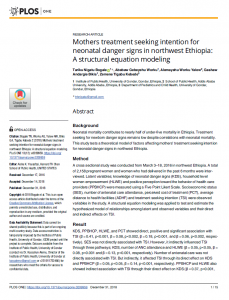
Abstract
Background
Neonatal mortality contributes to nearly half of under-five mortality in Ethiopia. Treatment seeking for newborn danger signs remains low despite correlations with neonatal mortality. This study tests a theoretical model of factors affecting mothers’ treatment seeking intention for neonatal danger signs in northwest Ethiopia.
Method
A cross sectional study was conducted from March 3–18, 2016 in northwest Ethiopia. A total of 2,158 pregnant women and women who had delivered in the past 6 months were interviewed. Latent variables; knowledge of neonatal danger signs (KDS), household level women empowerment (HLWE) and positive perception toward the behavior of health care providers (PPBHCP) were measured using a Five Point Likert Scale. Socioeconomic status (SES), number of antenatal care attendance, perceived cost of treatment (PCT), average distance to health facilities (ADHF) and treatment seeking intention (TSI) were observed variables in the study. A structural equation modeling was applied to test and estimate the hypothesized model of relationships among latent and observed variables and their direct and indirect effects on TSI.
Result
KDS, PPBHCP, HLWE, and PCT showed direct, positive and significant association with TSI (β = 0.41, p<0.001, β = 0.08, p<0.002, β = 0.18, p<0.001, and β = 0.06, p<0.002, respectively). SES was not directly associated with TSI. However, it indirectly influenced TSI through three pathways; KDS, number of ANC attendance and HLWE (β = 0.05, p<0.05, β = 0.08, p<0.001 and β = 0.13, p<0.001, respectively). Number of antenatal care was not directly associated with TSI. But indirectly, it affected TSI through its direct effect on KDS and PPBHCP (β = 0.05, p<0.05, β = 0.14, p<0.001, respectively). PPBHCP and HLWE also showed indirect association with TSI through their direct effect on KDS (β = 0.37, p<0.001, β = 0.36, p<0.001, respectively). All in all, the model fitted the sample data and explained 31% of the variance in TSI.
Conclusion
PPBHCP, HLWE, PCT and KDS were associated with mothers’ TSI for newborn danger signs.
Access the original article and any supplementary material here.